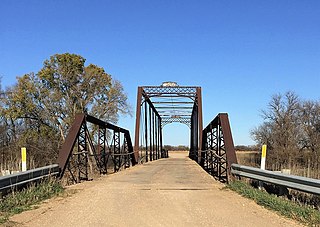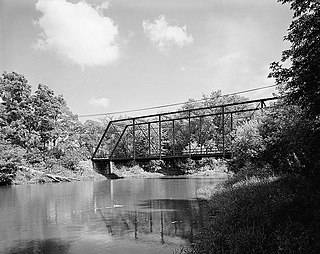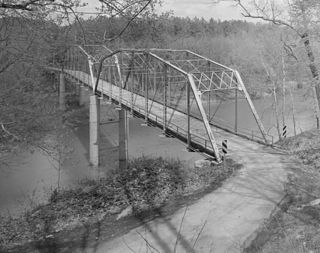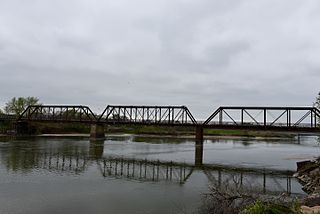
A truss bridge is a bridge whose load-bearing superstructure is composed of a truss, a structure of connected elements, usually forming triangular units. The connected elements may be stressed from tension, compression, or sometimes both in response to dynamic loads. The basic types of truss bridges shown in this article have simple designs which could be easily analyzed by 19th and early 20th-century engineers. A truss bridge is economical to construct because it uses materials efficiently.

The Denver, South Park, and Pacific Railroad was a historic 3 ft narrow gauge railroad that operated in Colorado in the western United States in the late 19th century. The railroad opened up the first rail routes to a large section of the central Colorado mining district in the decades of the mineral boom. The railroad took its name from the fact that its main line from Denver ascended the Platte Canyon and traversed South Park. Founded in 1872 by Colorado Governor John Evans, the company was purchased by the Union Pacific Railway in 1880, though it continued to be operated independently. The line went bankrupt in 1889 and was reorganized under the new moniker the Denver, Leadville and Gunnison Railway. When the Union Pacific went bankrupt in 1893, the DL&G lines went into receivership and were eventually sold to the Colorado and Southern Railway. In the first half of the 20th century, nearly all the company's original lines were dismantled or converted into 4 ft 8+1⁄2 instandard gauge. The last train to run the old DSP&P tracks was from Como, Colorado on April 11, 1937. A section of the standard gauge line between Leadville and Climax is still operated as a passenger excursion railroad called the Leadville, Colorado and Southern Railroad. At its peak the Denver, South Park and Pacific Railroad had 335 miles (539 km) of narrow gauge line, making it the largest narrow gauge railroad in the state of Colorado.

The Laughery Creek Bridge is a triple whipple truss bridge on the border of Dearborn County, Indiana, and Ohio County, Indiana. It crosses Laughery Creek. This bridge was built in 1878. The Wrought Iron Bridge Company, a prolific late 19th-century bridge company, constructed the bridge. The bridge is seated on stone abutments. The deck surface is not original and is currently concrete. The bridge, nearly 300 feet in length, is a single span pin connected triple intersection Whipple through truss, and is the only example in the world of this truss type. The name bridge's nickname, "Triple Whipple Bridge" is a play on words. The double-intersection Pratt, which was called the Whipple truss configuration, was a far more common variation of the standard Pratt configuration. Since the Laughery Creek Bridge's members have three intersections instead of two, this gives rise to the "Triple Whipple" name. This bridge was listed on the National Register of Historic Places in 1976.

The Phoenix Iron Works, located in Phoenixville, Pennsylvania, was a manufacturer of iron and related products during the 19th century and early 20th century. Phoenix Iron Company was a major producer of cannons for the Union Army during the American Civil War. The company also produced the Phoenix column, an advance in construction material. Company facilities are a core component of the Phoenixville Historic District, a National Register of Historic Places site that was in 2006 recognized as a historic landmark by ASM International.

Pott's Ford Bridge is a bridge 1/2 mile south of Glasco, Kansas, USA that spans the Solomon River in Cloud County, Kansas. It has a wooden deck with three bowstring pony trusses and one Pratt pony truss. The lengths of the trusses are 48 feet (15 m), 46 feet (14 m), and 149 feet (45 m) for the bowstring trusses, and 72 feet (22 m) for the Pratt truss. It was built in 1884 by the Wrought Iron Bridge Company of Canton, Ohio.

The Riverside Avenue Bridge is the only cast-iron bridge in Connecticut and one of a small number still in use in the United States. It carries Riverside Avenue over the New Haven Line railroad tracks in the Riverside section of Greenwich, Connecticut. The bridge was part of an earlier span built in 1871 over the Housatonic River by the New York and New Haven Railroad, and when that bridge was replaced, part of it was erected in Riverside in 1895. It was placed on the National Register of Historic Places in 1977.

19th Street Bridge is a two-span through Pratt truss road bridge in Denver, Colorado, over the South Platte River, now used for pedestrians. It was built in 1888 to replace a wooden structure and carried automobile traffic until 1986. The bridge is listed on the National Register of Historic Places.

The Saugatuck River Bridge is a bridge in Connecticut carrying Route 136 over the Saugatuck River in Westport. The bridge, built in 1884, is the oldest surviving movable bridge in Connecticut and is listed on the National Register of Historic Places. The total length of the bridge is 87.5 metres (287 ft) with a deck width of 6.1 metres (20 ft) and a minimum vertical clearance of 2.1 metres (6.9 ft) above the river. The bridge carries an average of about 16,000 vehicles per day. In 2007, the bridge was named the William F. Cribari Memorial Bridge.

The Jackson Branch Bridge No. 15, also known as the Tecumseh Railroad Bridge due to its close proximity to the city of Tecumseh, is a historic railway deck truss bridge that spans the River Raisin in rural Raisin Charter Township in Lenawee County, Michigan. The bridge was added to the National Register of Historic Places on December 4, 2001.

The Clinton Falls Bridge, also known as the Old Mill Bridge and formally as Bridge L-5573, is a historic steel Pratt through truss bridge that spans the Straight River in Clinton Falls Township, Minnesota. It was listed on the National Register of Historic Places in 1997 as Bridge No. L-5573 for having local significance in the theme of engineering. It was nominated for being an example of early steel truss bridge design in Minnesota.

The Pine Mill Bridge is an historic structure located in Wildcat Den State Park in rural Muscatine County, Iowa, United States. It was built in 1878 near the Pine Creek Gristmill, the only place in Iowa where a mill and bridge combination remains in place. The bridge was listed on the National Register of Historic Places in 1998 as a part of the Highway Bridges of Iowa MPS.

The Upper Paris Bridge is an historic structure located near the town of Coggon in rural Linn County, Iowa, United States. The pin-connected Whipple through truss bridge was built in 1879 as a wagon bridge. It was designed by the Wrought Iron Bridge Company of Canton, Ohio. The bridge was listed on the National Register of Historic Places in 1998 as a part of the Highway Bridges of Iowa MPS.

The Indian Creek Bridge is a wrought iron bridge, built about 1880 to the east of Cedar Rapids, Iowa. The bridge crosses a tributary of the Cedar River in Linn County. It was designed and built by the Wrought Iron Bridge Company (WIBCO) of Canton, Ohio as an eight-panel pin-connected through truss in an unusual double-intersection Pratt design.

The Turtleville Iron Bridge is an overhead truss bridge built in 1887 where South Lathers Road crosses Turtle Creek near Beloit, Wisconsin. It was added to the National Register of Historic Places in 1977.

Clarkton Bridge was a historic Pratt truss bridge located over the Staunton River near Nathalie, in Charlotte County, Virginia. It was built in 1902 by the Virginia Bridge & Iron Co., and was the only remaining metal truss structure in Virginia built for highway purposes, which was supported by steel cylinder piers. It consisted of two camelback, pin-connected steel through truss channel spans, and twelve steel deck beam approach spans. The overall dimensions of the bridge approach and truss spans were as follows: north approach, 370 feet (110 m) with twelve deck spans; north truss, 150 feet (46 m); south truss, 150 feet (46 m). The total length of the bridge was 692 feet (211 m).

The Iron Bridge at Howard Hill Road is a modern pony truss bridge, carrying Howard Hill Road across the Black River in southeastern Cavendish, Vermont. It is a replacement for an historic 1890 Pratt through truss bridge, which is now in storage. The historic bridge was listed on the National Register of Historic Places in 1982.

The Wabash Railroad Bridge is a historic structure located south of Pella, Iowa, United States. It spans the Des Moines River for 561 feet (171 m). The Des Moines and St. Louis Railroad (D&S) was built through the central part of Marion County in 1882. This bridge was probably built at that time. It is a three span, wrought iron, Pratt through truss manufactured by the Carnegie Steel Company. The Wabash, St. Louis and Pacific Railroad, the Wabash Railroad, eventually acquired the D&S and this bridge. It remained in use as a railroad bridge until about 1946 when the county acquired the bridge and the right-of-way for a county road. They rehabilitated it in 1951, replacing part of the substructure. The bridge was listed on the National Register of Historic Places in 1998.

The New Hampton Pony Pratt Truss Bridge is a historic pony Pratt truss bridge on Shoddy Mill Road in New Hampton of Lebanon Township, Hunterdon County, New Jersey. It crosses the Musconetcong River between Lebanon Township, Hunterdon County and Washington Township, Warren County. It was designed by Francis C. Lowthorp and built in 1868 by William Cowin of Lambertville, New Jersey. The bridge was added to the National Register of Historic Places on July 26, 1977 for its significance in engineering, industry and transportation. It is one of the few early examples of iron Pratt truss bridges remaining in the United States. It was later documented by the Historic American Engineering Record in 1991. It was added as a contributing property to the New Hampton Historic District on April 6, 1998.

The Main Street Bridge, once known as the West Main Street Bridge, is a historic pony Pratt truss bridge crossing the South Branch Raritan River in Clinton of Hunterdon County, New Jersey. It was designed by Francis C. Lowthorp and built in 1870 by William Cowin of Lambertville. The bridge was added to the National Register of Historic Places on September 28, 1995 as part of the Clinton Historic District. It is one of the few early examples of iron Pratt truss bridges remaining in the United States. It was documented by the Historic American Engineering Record in 1991.

The Glen Gardner Pony Pratt Truss Bridge is a historic pony Pratt truss bridge on School Street crossing the Spruce Run in Glen Gardner of Hunterdon County, New Jersey. It was designed by Francis C. Lowthorp and built in 1870 by William Cowin of Lambertville, New Jersey. The bridge was added to the National Register of Historic Places on September 22, 1977 for its significance in engineering, industry and transportation. It is one of the few early examples of iron Pratt truss bridges remaining in the United States. It was later documented by the Historic American Engineering Record in 1991.





















